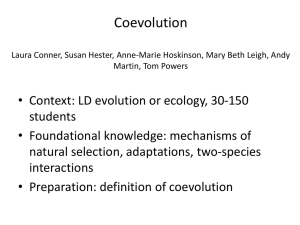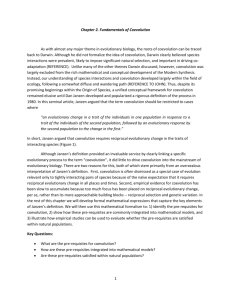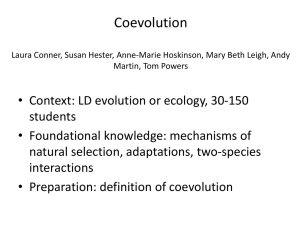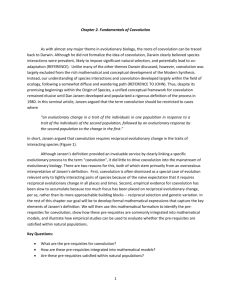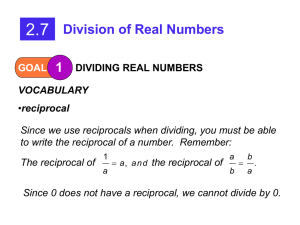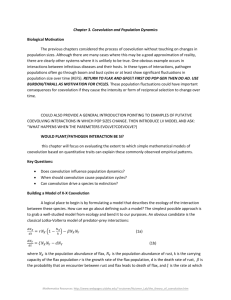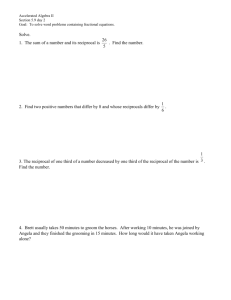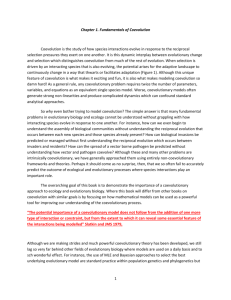Chapter 2. Fundamentals of Coevolution INSERT INTRODUCTORY
advertisement
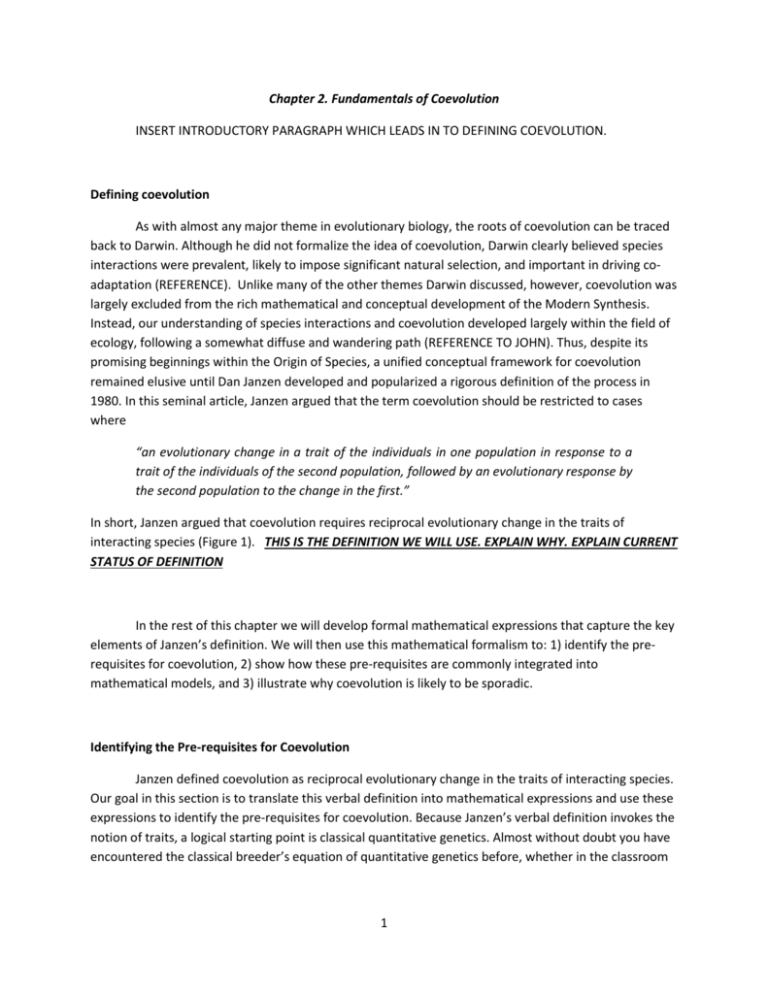
Chapter 2. Fundamentals of Coevolution INSERT INTRODUCTORY PARAGRAPH WHICH LEADS IN TO DEFINING COEVOLUTION. Defining coevolution As with almost any major theme in evolutionary biology, the roots of coevolution can be traced back to Darwin. Although he did not formalize the idea of coevolution, Darwin clearly believed species interactions were prevalent, likely to impose significant natural selection, and important in driving coadaptation (REFERENCE). Unlike many of the other themes Darwin discussed, however, coevolution was largely excluded from the rich mathematical and conceptual development of the Modern Synthesis. Instead, our understanding of species interactions and coevolution developed largely within the field of ecology, following a somewhat diffuse and wandering path (REFERENCE TO JOHN). Thus, despite its promising beginnings within the Origin of Species, a unified conceptual framework for coevolution remained elusive until Dan Janzen developed and popularized a rigorous definition of the process in 1980. In this seminal article, Janzen argued that the term coevolution should be restricted to cases where “an evolutionary change in a trait of the individuals in one population in response to a trait of the individuals of the second population, followed by an evolutionary response by the second population to the change in the first.” In short, Janzen argued that coevolution requires reciprocal evolutionary change in the traits of interacting species (Figure 1). THIS IS THE DEFINITION WE WILL USE. EXPLAIN WHY. EXPLAIN CURRENT STATUS OF DEFINITION In the rest of this chapter we will develop formal mathematical expressions that capture the key elements of Janzen’s definition. We will then use this mathematical formalism to: 1) identify the prerequisites for coevolution, 2) show how these pre-requisites are commonly integrated into mathematical models, and 3) illustrate why coevolution is likely to be sporadic. Identifying the Pre-requisites for Coevolution Janzen defined coevolution as reciprocal evolutionary change in the traits of interacting species. Our goal in this section is to translate this verbal definition into mathematical expressions and use these expressions to identify the pre-requisites for coevolution. Because Janzen’s verbal definition invokes the notion of traits, a logical starting point is classical quantitative genetics. Almost without doubt you have encountered the classical breeder’s equation of quantitative genetics before, whether in the classroom 1 as part of a course in evolutionary biology or quantitative genetics, or perhaps more unexpectedly and unpleasantly as part of your prelims: ∆𝑧̅ = ℎ2 𝑆. (1) The terms in equation (1) all have familiar and intuitive meanings: ∆𝑧̅ is the change in the population mean value of phenotype z that occurs over a single generation, ℎ2 is the narrow sense heritability, and S is the selection differential. Thus, equation (1) emphasizes that for natural selection to cause evolution, there must be additive genetic variation (ℎ2 > 0) and an association between phenotypes and fitness (𝑆 ≠ 0). In order to accommodate Janzen’s definition, we will obviously need to extend the simple breeder’s equation (1) to a scenario with two interacting species, say species X and species Y, with traits x and y: ∆𝑥̅ = ℎ𝑥2 𝑆𝑥 (2a) ∆𝑦̅ = ℎ𝑦2 𝑆𝑦 (2b) where each species is now characterized by its own heritability and selection differential. With equations (2) we have managed to capture a significant chunk of Janzen’s definition. Specifically, we now have mathematical expressions for evolutionary change in the traits of interacting species. What our equations miss, however, is the most critical word in Janzen’s definition: reciprocal. The clearest and most biologically relevant way in which reciprocal evolution can be integrated into (2) is by assuming that the selection differential acting on each species depends on the frequency distribution of traits within the interacting species: ∆𝑥̅ = ℎ𝑥2 𝑆𝑥 (𝜑𝑦 ) (3a) ∆𝑦̅ = ℎ𝑦2 𝑆𝑦 (𝜑𝑥 ) (3b) where 𝜑𝑥 is the frequency distribution of trait x and 𝜑𝑦 is the frequency distribution of trait y (FIGURE 1). With equations (3) in hand, we have a very general mathematical formulation for reciprocal evolutionary change in interacting species driven by reciprocal selection. In addition to formalizing Janzen’s seminal definition, equations (3) illuminate two pre-requisites for coevolution: Pre-requisite 1 — There must be additive genetic variation for the traits mediating an interspecific interaction Pre-requisite 2 — Selection acting on the traits mediating the interaction must depend upon the distribution of phenotypes within the interacting species In the following sections, we will explore how these pre-requisites are generally integrated into coevolutionary models of different types and evaluate the extent to which these pre-requisites are satisfied in natural populations. 2 Integrating the Pre-requisites for Coevolution into Mathematical Models The pre-requisites for coevolution imposed by Janzen’s definition suggest that all coevolutionary models must include two fundamental ingredients: 1) a mechanism of inheritance and 2) a mechanism of reciprocal selection based on individual phenotypes. Although this can be accomplished in many ways, substantial confusion persists within the literature over what, exactly, a model must include to be truly coevolutionary. Perhaps the single most common break from Janzen’s definition arises within models employing INDIRECT COEVOLUTION MEDIATED BY POPULATION DENSITIES. Often such models integrate reciprocal evolutionary change only indirectly, through feedbacks driven by changes in population densities rather than the traits of individuals (REFS). Although interesting and biologically relevant, such models do not qualify as coevolutionary using Janzen’s definition because they lack a direct feedback between traits of the interacting species. Because of its historical importance and precedent, as well as its clarity, we will adhere to Janzen’s definition throughout this book and study only models that include the two pre-requisites identified above. The bulk of coevolutionary theory which meets these criteria can be rather crudely lumped into studies which employ either a quantitative genetic or population genetic approach. In the sections below, we will explore how the pre-requisites for coevolution are generally integrated into these two different modeling frameworks. Quantitative Genetics Models developed within the framework of quantitative genetics assume that a continuously variable trait (or suite of traits) within one species interacts functionally with a continuously variable trait (or suite of traits) within another species. Reciprocal selection is often integrated into such models using an interaction function which predicts the outcome of encounters between individuals as a function of their phenotypes. For instance, whether a Cheetah captures and consumes an Impala could depend on running speed in both Cheetah and Impala such that the probability of capture, P, could be described by the function: 1 𝑃 = 1+𝐸𝑥𝑝[𝑥−𝑦] (4) where x is the maximum running speed of the Cheetah and y the maximum running speed of the Impala (Figure X). Since we can safely assume being captured by a cheetah is detrimental to Impala fitness but beneficial to cheetah fitness, we can easily incorporate the interaction function P into expressions describing the fitness consequences of an encounter between Cheetah and Impala: 𝑊𝑋 = 1 + 𝑆𝑋 𝑃(𝑥, 𝑦) (5a) 𝑊𝑌 = 1 − 𝑆𝑌 𝑃(𝑥, 𝑦) (5b) where the coefficients 𝑆𝑋 and 𝑆𝑌 measure how much capturing an Impala improves Cheetah fitness and how much being captured by a Cheetah reduces Impala fitness, respectively. Biologically, fitness equations (5) capture the idea that an encounter between a slow Impala and a fast Cheetah is likely to improve Cheetah fitness at the expense of Impala fitness whereas encounters between a slow Cheetah 3 and a speedy Impala is unlikely to improve Cheetah fitness or reduce Impala fitness. With equations (5) in hand, classical quantitative genetics tools can be used to calculate the strength of selection acting on each of the interacting species (see Chapter 4 for details). As long as selection on each of the species depends on the phenotype distribution within the interacting species, selection is reciprocal. In contrast to the detailed mechanistic integration of reciprocal selection, inheritance is included within quantitative genetic models of coevolution only implicitly, and represented only by a fixed parameter summarizing the amount of additive genetic variance available to fuel a response to reciprocal selection (see Chapter 4 for details). Consequently, the second pre-requisite for coevolution — additive genetic variation for the traits mediating the interaction — is automatically satisfied within such models. Assuming additive genetic variance is fixed can be justified over relatively short evolutionary timescales by assuming traits are controlled by a very large number of genes such that the strength of selection acting on any single gene is quite weak. Under such conditions, mutation can — in principle — replenish additive genetic variation at a rate equivalent to the rate at which it is depleted by natural selection (REFS). Of course, we know that additive genetic variance is not always constant, but can instead evolve quite rapidly under some circumstances (REFS). In such cases, more complex models which allow additive genetic variance to evolve become more appropriate (REFS). In these more complex models, the potential for coevolution can wax and wane as the amount of additive genetic variation for the traits mediating the interaction fluctuates over time (REFS). Population Genetics Models based within the framework of population genetics assume that a discrete trait (or group of traits) within one species interacts functionally with a discrete trait (or group of traits) within another species. Often, the traits in such models are implicit with the focus instead on the direct interaction between a gene (or collection of genes) within one species and a gene (or collection of genes) within another. Reciprocal selection is often integrated into such models using an interaction matrix which predicts the outcome of encounters between individual genotypes. For instance, whether a rust fungus successfully infects a potential host plant (outcome) could depend on the particular variant of a surface protein elicitor on the rust (genotype) and the particular variant of a recognition molecule in the plant (genotype) such that the probability of infection, α, is described by a matrix: Plant recognition genotype bb Bb BB AA 0.85 0.82 0.84 Rust Aa 0.82 0.25 0.27 elicitor genotype aa 0.79 0.22 0.26 where each entry represents the probability that an encounter between a plant genotype and rust genotype leads to infection of the host. When an encounter between a rust (X) and plant (Y) leads to infection, it seems reasonable to assume the fitness of the rust is increased by some amount 𝑆𝑋 while the fitness of the plant is decreased by some amount 𝑆𝑌 . Generally, these assumptions lead to the 4 formulation of expressions for the fitness of individuals of the two species when an encounter occurs between a rust of genotype i and plant of genotype j: 𝑊𝑋,𝑖 = 1 + 𝑆𝑋 𝛼𝑖,𝑗 (8a) 𝑊𝑌,𝑗 = 1 − 𝑆𝑌 𝛼𝑖,𝑗 (8b) where the value of 𝛼𝑖,𝑗 is given by the matrix entry for the appropriate combination of plant and rust genotypes. Biologically, fitness equations (8) capture the idea that an encounter between a rust and host which eludes detection by the host immune system is likely to improve rust fitness at the expense of plant fitness whereas an encounter between a rust and host which elicits a host immune defense is unlikely to improve rust fitness or reduce host fitness. From this point, standard expressions drawn from population genetics can be used to evaluate the strength of selection acting on each species (See Chapter 3 for details). In contrast to quantitative genetics, models employing a population genetic approach explicitly model inheritance and thus allow the influence of genetic details, such as rates of segregation and recombination to be studied (See chapters 5 and 6 for details). Of course, all of this genetic richness comes at a high mathematical price. For even a single pair of coevolving diploid species whose interaction is mediated by just two diallelic loci, a full mathematical description of the coevolutionary process requires NINE equations for each species! Largely for this reason, we have a wealth of single locus models and strong bias toward haploid organisms. Fortunately, coevolutionary models are now beginning to move beyond these very simple genetic scenarios by employing moment based approaches and separation of time scales approximations which allow more complex multi-locus models to be studied (REFS). These approaches will be introduced in Chapters X and X and used to study how and when coevolution can drive the evolution of sexual reproduction. In summary, all coevolutionary models include mechanisms of reciprocal selection and inheritance. Although the details and subtleties of inheritance and the mechanistic basis of interaction differ widely among models, all are united by a single essential feature: an interspecific interaction between the heritable phenotypes of individuals capable of generating reciprocal selection on the interacting organisms. The sporadic nature of reciprocal selection and coevolutionary change Before we move on to discuss empirical support for the key pre-requisites of coevolution — reciprocal selection and additive genetic variation — it is crucial to address one very common misconception: the frequency with which coevolutionary models actually generate reciprocal selection and reciprocal evolutionary change. As we saw in the previous section, all coevolutionary models include mechanisms that can generate reciprocal selection and can allow for the inheritance of traits mediating the interaction. What we did not see, however, is that these models do not actually generate reciprocal selection and reciprocal evolutionary change —coevolution using Janzen’s strict definition — at all points in time. Instead, your average, garden variety coevolutionary model might generate empirically detectable reciprocal selection or reciprocal evolutionary change only sporadically, in perhaps 25-75% of 5 generations or “field seasons”, or might produce little or no reciprocal evolutionary change for thousands of generations before unleashing a torrent of extremely rapid coevolutionary change in a single burst (Figure XX). Although it is premature to delve into the nuanced reasons coevolutionary change can be so sporadic (since we have yet to analyze even a single coevolutionary model!) the basic reasons are that: 1) the strength of reciprocal selection waxes and wanes as the phenotype distributions of the interacting species continually adjust and readjust to one another over evolutionary time, and 2) additive genetic variance underlying traits mediating interactions can fluctuate significantly over time in response to reciprocal selection. Thus, as Thompson has long argued (REFS), it is naïve to expect coevolution to be ongoing and strong enough to be detectable in all populations and all times. This fundamental result, which emerges over and over again from all types of coevolutionary models, has important consequences for the design and interpretation of studies investigating coevolution within natural populations. 6

